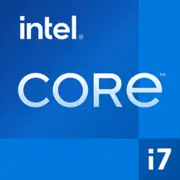Intel Core i7-5600U

Intel Core i7-5600U: A Compact Processor for Mobility and Everyday Tasks
Overview of the 2015 Processor in the Context of 2025
Architecture and Process Technology: A Balance Between Efficiency and Performance
The Intel Core i7-5600U, released in 2015, belongs to the Broadwell generation and is manufactured using a 14-nanometer process technology. This was a significant advancement from the 22-nm Haswell architecture, allowing for reduced power consumption and improved thermal characteristics.
Key Specs:
- Cores and Threads: 2 physical cores with Hyper-Threading support (4 threads).
- Clock Speeds: Base clock of 2.6 GHz, maximum in Turbo Boost mode of 3.2 GHz.
- Cache: L3 cache of 4 MB, which was standard for dual-core processors of that time.
- Integrated Graphics: Intel HD Graphics 5500 with 24 execution units (EU) and clock speeds up to 950 MHz.
The Broadwell architecture optimized instructions per clock (IPC), enhancing performance in single-thread tasks. However, the two-core limitation kept multithreading as a weak point. The HD 5500 GPU supported DirectX 11.2 and 4K output via DisplayPort, but it was only suitable for the most undemanding games.
Power Consumption and TDP: An Ideal Choice for Ultrabooks
The processor's TDP (Thermal Design Power) is 15 W, making it perfect for thin laptops and ultrabooks. Compared to more powerful chips (such as the 45-watt Core i7-H series), the i7-5600U emits less heat, allowing for passive cooling or compact coolers.
Power-Saving Technologies:
- Intel SpeedStep: Dynamically adjusts frequency and voltage based on load.
- Turbo Boost 2.0: Temporarily increases frequency to 3.2 GHz for intensive tasks.
- C-States: Manages power consumption during idle periods.
These technologies enable the processor to operate for 8 to 10 hours in devices with a battery capacity of 50-60 Wh (for example, the Dell XPS 13 from 2015), but in modern 2025 laptops with optimized operating systems and larger batteries, battery life may exceed these figures.
Performance: Suitable for Office and Multimedia, but Not for Gaming
Geekbench 6 (2023 Test):
- Single-Core: 911 points.
- Multi-Core: 1728 points.
Real-World Scenarios:
- Office Tasks: Document editing, browser (10+ tabs), video conferencing — the processor handles these without lag.
- Multimedia: Playback of 4K video, streaming, basic photo editing in Lightroom.
- Gaming: Only light games at 720p/1080p resolution (e.g., Minecraft, Dota 2 on low settings — 30–40 FPS).
Turbo Boost Mode: Under heavy single-core load (e.g., file archiving), the frequency rises to 3.2 GHz, but under prolonged load, throttling may occur due to overheating in compact chassis.
Use Cases: Who is the Core i7-5600U Suitable for in 2025?
This processor is relevant for:
1. Students and Office Workers: Working with text, spreadsheets, presentations, and using Zoom/Teams.
2. Users Who Value Portability: Ultrabooks weighing up to 1.3 kg (e.g., Lenovo ThinkPad X250).
3. The Second-Hand Market: Laptops with i7-5600U can be found in 2025 for $200–$300 in refurbished condition.
Not Suitable For:
- Professional video editing or 3D rendering.
- Modern gaming (even indie projects like Hades require more powerful graphics).
Battery Life: How Does the Processor Affect Running Time?
With a TDP of 15 W and support for power-saving technologies, laptops with the i7-5600U in 2025 could demonstrate the following results:
- Web/Video Browsing: Up to 10–12 hours (at a screen brightness of 150 nits and a 60 Wh battery).
- Work in Office Applications: 8–9 hours.
- Idle (sleep mode): Up to 2 weeks in Connected Standby.
Tip: For maximum battery life, choose models with low-resolution IPS screens (1366x768) and SSDs instead of HDDs.
Comparison with Competitors: How Does It Stack Up Against AMD and Apple?
AMD A10-8700P (2015):
- 4 cores/4 threads, but weaker in single-core performance (Geekbench 6: ~700/2200).
- Radeon R6 graphics are more powerful than HD 5500, but TDP is between 15-35 W.
Apple A8 (2014):
- Used in the MacBook 12" 2015. Single-Core: ~800, Multi-Core: ~1400.
- Better optimization for macOS but limited software compatibility.
Intel Core i5-5200U (Comparable):
- Lower clock speeds (2.2–2.7 GHz), but in 2025, the difference from the i7-5600U is minimal.
Conclusion: The i7-5600U remains competitive in the basic tasks segment but lags behind modern 12th-generation Intel chips (e.g., Core i5-1235U) in multithreading.
Pros and Cons: Is It Worth Considering in 2025?
Pros:
- Low power consumption and compact size.
- Sufficient performance for everyday tasks.
- Affordable price on the second-hand market.
Cons:
- 2 cores limit multitasking capabilities.
- Weak graphics for modern applications.
- Lack of support for DDR5 and Thunderbolt 4.
Recommendations for Laptop Selection
If you are considering devices with the i7-5600U in 2025, pay attention to:
1. Device Type: Ultrabooks or business laptops (Dell Latitude, HP EliteBook).
2. Screen: Full HD (1920x1080) for comfortable work.
3. Storage: Make sure it has an SSD (minimum 256 GB).
4. Ports: USB 3.0, HDMI for connecting monitors.
Examples of Models from 2015–2016:
- Lenovo ThinkPad T450s (refurbished price: ~$250).
- Dell XPS 13 9343 (refurbished price: ~$300).
Important: Check the battery condition — replacement can cost $50–$80.
Final Conclusion: Who Is the Core i7-5600U Suitable For?
This processor is a choice for those looking for an affordable laptop for basic tasks: document work, web surfing, and movie watching. It is suitable for:
- Students for studying.
- Office workers who do not require high performance.
- Users who value portability and battery life.
Key Benefits: Low price, reliability, and sufficient performance for its age. However, for modern tasks (AI, 4K streaming, gaming), it is better to choose newer models.
Basic
CPU Specifications
Memory Specifications
GPU Specifications
Miscellaneous
Benchmarks
Compared to Other CPU
Share in social media
Or Link To Us
<a href="https://cputronic.com/cpu/intel-core-i7-5600u" target="_blank">Intel Core i7-5600U</a>